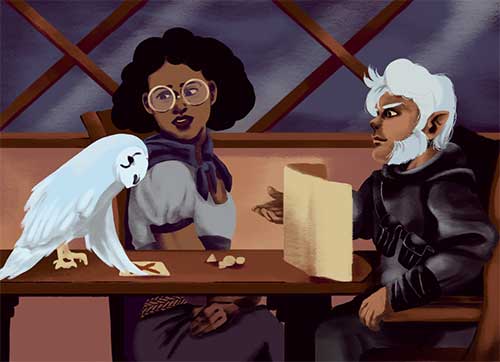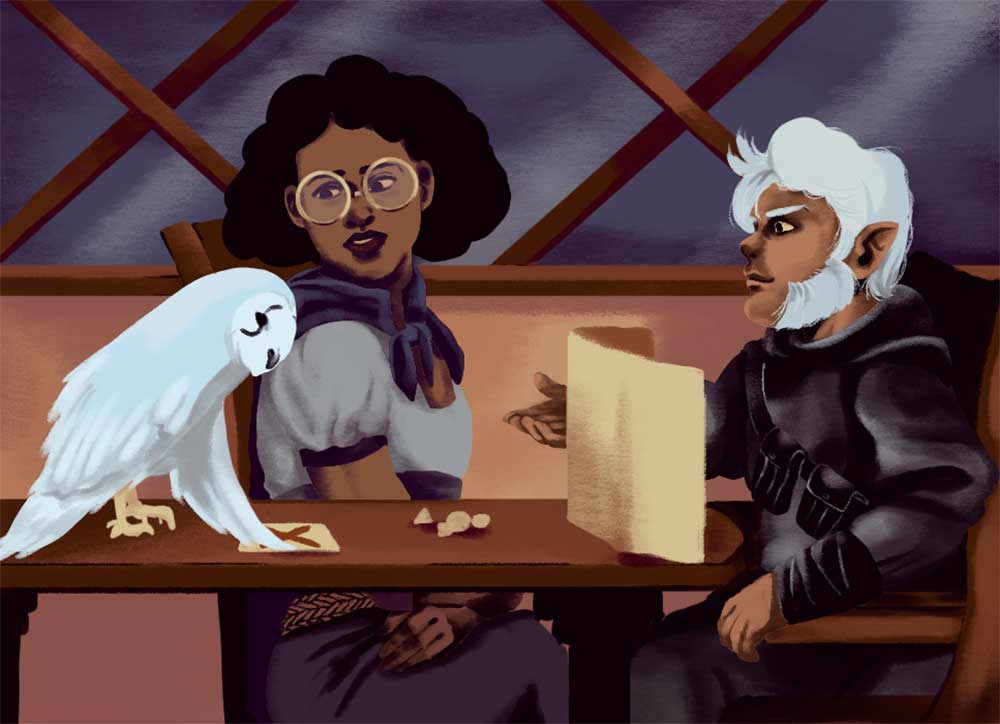Running the Game: Romantic Entanglements
- February 27, 2019
- Articles
- Posted by Joseph D. Carriker, Jr
- Comments Off on Running the Game: Romantic Entanglements
From the intrigue-laden romantic lives of your setting’s nobles to the pastoral bliss of the innkeep and her doting wife, from the jaded rake who takes a moment away from flirting to sell the player characters some information to the young lovers who defy social convention to pursue their own star-crossed affections: Love and relationships form a great deal of the backdrops of many game and fictional settings.
If that’s the case, why does it so rarely show up at the gaming table within the purview of the player characters, then?
We’re going to look at some ways to navigate this element of roleplaying games and how to use them to your group’s best advantage, all the while dodging squicky or awkward situations to the best of our ability. Whether you’d like to just highlight some background relationships in your character dynamics or play in a campaign with romantic attraction featured front and center, we’re going to look at some ways to include these sorts of romantic entanglements.
With any luck, by the time we’re done here, you’ll feel ready to add a little of the amour to your adventure gaming.
Though much of the advice in this article presumes romances involve a player character and a non-player character, it is easy enough to adapt some of its advice for burgeoning relationships between player characters, if the group wishes. It also assumes that you’re the one running the game, though there’s no reason a player can’t help the Game Master by playing “campaign Cupid,” helping to set up the advice given in this article.
The Role of Loved Ones
 Before we go into the how, it’s worth exploring the why. That is, why make a point of including romantic dynamics within the roleplaying game?
Before we go into the how, it’s worth exploring the why. That is, why make a point of including romantic dynamics within the roleplaying game?
Connections to the Past. Romantic connections—even those that are no longer active, and maybe haven’t been in a long time—create connections to a player character’s back story. A long-standing romantic partner or spouse probably knows the character better even than their boon adventuring companions…or at least, they know them differently.
Likewise, a player character’s former love interests can provide tangible links to that character’s origins. Were they apprenticed with the same swordmaster? Did one keep lookout while the other got up to mischief in the temple when both were acolytes? Did they both come from the same small farming community, before the player character was renowned as a hero? These experiences inform how that character views and treats the player character, which in turn shapes how others (particularly other player characters) interact with them.
Character Development. A romantic tie need not be an old one to contribute to a character’s depth. How a character makes their affections known to a love interest and interacts with that burgeoning relationship builds interesting detail into a player character’s identity.
This is particularly rich when their behavior is seemingly at odds with their “adventuring party identity.” The snarling barbarian who is oddly tender and loves to brush his lady-love’s hair, the normally rakish bard given to tongue-tied blushing around the one he is swooning over, the warlock torn between his affections and his desire to protect his paramour by sequestering them away from the darker, dangerous part of his life: All of these build an additional layer of interesting character, both for the character’s player and for the other players around the table.
Moreover, the presence of such characters adds development to more than just the romantic interest. How does the party’s rogue regard the lass his good friend is spending all his time with, and how does the fighter respond when a party member’s loved one sneakily corners them and begs them to protect their beloved? These responses all provide for some great development and roleplaying opportunities around the table.
Vital and Living NPCs. One of the elements that can’t be understated about relationships (romantic, certainly, but all relationships to some degree) is that they cause characters to become involved in one another’s lives in direct ways. The events in an NPC’s life are no longer things happening to someone else at that point—they affect the player character, as well. Positive things uplift both of them, and tragedies affect both as well. (Do see Ways to Make It Work, below, for more on that, however.)
When narratives seem to focus on events going on in a non-player character’s life, it can sometimes come across as a bit of “us standing around while story happens to someone else.” While this is still a danger, when that NPC happens to be involved with one of the player characters, there’s a deeper investment: That character’s story is also part of the player character’s story.
Player Buy-In
Before we go any further, you’ll need one main thing: player buy-in. By that, we mean ensuring your fellow players are interested in this style of play.
Take a moment to discuss expectations and limits for this style of play within your group. Make sure to emphasize that everyone’s comfort is foremost in consideration of using these kinds of storytelling techniques.
Moreover, make sure that everyone knows that the consent of the participating players is absolutely essential. If someone does not want to roleplay these sorts of situations, then that’s the final word on the topic.
Discussion about including this material can and should include boundaries: To what extent is such gameplay out in the open? Some groups may enjoy actual roleplay during provocative scenes of flirting or even intimacy (focusing on verbal exchanges over narrative description), while others may enjoy the lead-in to such culminations while allowing the scene to “fade to black” once everyone has a pretty good idea of what follows. Some players may prefer never to engage in that narrative, while others may want it to be a background element at most.
There’s no wrong way or right way to do this; only what is wrong or right for your group. Whatever your group decides, make sure to embrace the responsibility of the social contract of the gaming table: That is, each one of us is there not just to have fun, but to facilitate everyone else there having fun. Don’t make anyone uncomfortable, and be willing to be honest but non-confrontational if something makes you uncomfortable.
I highly suggest the use of the X-card, as innovated by John Stavropoulos. Better descriptions of the technique can be found online, but in summary, it’s a means of indicating to the gaming table when the topic of the game has begun to veer into a territory you are uncomfortable with.
By the simple expedient of a touch to the X-card itself, everyone knows to interpret that as a non-confrontational request that the group switch the course of the narrative away from where it’s headed at the moment. It’s a quick and simple method of signaling a companionable request for a shift in tone or content, without having to grind the game to a halt to justify or be interrogated.
In practice, this allows a greater expression of roleplaying freedom and exploration of content, as each player can confidently explore their narrative interests, secure in the knowledge that their fellows have a means of signaling discomfort should it arise.
Ways to Make It Work
So at this point, ideally, you’ve thought over the inclusion of romantic elements into your campaign, and conferred with the others in your gaming group to make sure everyone’s on the same page. Exactly how do you do this, though?
Every group is going to have different needs, but here are some useful techniques to integrate those kinds of storylines into the campaign.
Romantic Interests Gallery. As part of creating their characters, ask your players to find three to five images of people they feel their characters might be interested in. Not as a long-term thing, but in that “the first time I saw them, I couldn’t take my eyes off them” sort of initial impression.
On a practical level, this bypasses one of the major awkward elements of romance in gaming: the Game Master telling a player that their character is attracted to someone. Using this technique, it keeps the decision for whom the character might be interested in within the player’s hands, while making them available for the narrator to introduce and leverage that initial attraction in a predictable way.
Plus, it’s kind of a fun reveal with unexpected ramifications around the table: When the Game Master shows the image of the tyrant’s daughter to the group, one of the players realizes it’s one of his romantic gallery images, and so knows to roleplay that immediate (possibly dangerous) sense of being smitten in whatever way is appropriate to his character.
Confer with Players. As you introduce potential romantic interests, email or talk to players outside of the game, individually, to gauge their interest in taking part in that sort of plotline. There’s nothing that says romance (or any subplot, really) has to arise spontaneously at the table—rest assured, there will be more than enough spontaneity in play as the demands of the campaign impact that relationship.
This sort of backstage conversation should continue for the whole duration of that relationship, and for any others that come along.
Avoid Gamifying Romance. Though there’s nothing wrong with a quick social check here and there to determine how well someone comports themselves, remember that charismatic people are not the only ones who fall in love. Flirtation or even a seduction might answer to the dice, but don’t relegate the success or failure of a romance to the dice or other mechanic. It should be a story element, and roleplaying-focused, not a matter of “winning” at a dice roll.
Not a Reward. Along those lines, neither should romance be a “reward” for victory. As prevalent as “winning the hand of the lady fair by slaying the dragon” tropes are in Western fiction, it’s not a good model for gaming (and is really a throwback to women being considered property, and that’s definitely an unwelcome reference at the gaming table).
This isn’t to say that romantic interests can’t be impressed by our player character’s heroic actions. Far from it! But let those successes have their own rewards already built into the game, and have any romantic entanglement that arises after them be because they are the genuine response by the interest to the PC’s actions.
Avoid Fridging. Comics writer Gail Simone coined a term for the death of a love interest solely to motivate a hero: “fridging” (derived from a gruesome and weirdly repeated trope from comics).
Though the ugly trope properly refers to the way female characters are brutalized in fiction solely to serve as shocking motivation for male characters, this author advises that you extend the concept to encompass all love interests: Do not introduce them for the sole purpose of kidnapping, harming, or killing them to evoke a response from a player character.
This isn’t to say that loved ones can’t be endangered by the player character’s adventuring life, mind you. What I’m saying is that if your sole reason for introducing a romantic interest is to brutalize them as a cheap cattle prod to your player character(s), then possibly reconsider their introduction at all.
Moreover, if they are put in harm’s way in any capacity, it should be with the express permission of that player, per Confer with Players above. Such stories may indeed make for good drama, they are also the sort of stories you shouldn’t force on others without their okay.
With all of these things in mind, hopefully you’ll find the path a little clearer for introducing a little love into the lives of your table’s heroes.
 Joseph D. Carriker, Jr. is a tabletop roleplaying game designer and novelist. His first novel, Sacred Band is about a team of LGBTQ+ superheroes. He lives in Portland, Oregon with his partner, A.J. @oakthorne on Twitter.
Joseph D. Carriker, Jr. is a tabletop roleplaying game designer and novelist. His first novel, Sacred Band is about a team of LGBTQ+ superheroes. He lives in Portland, Oregon with his partner, A.J. @oakthorne on Twitter.


